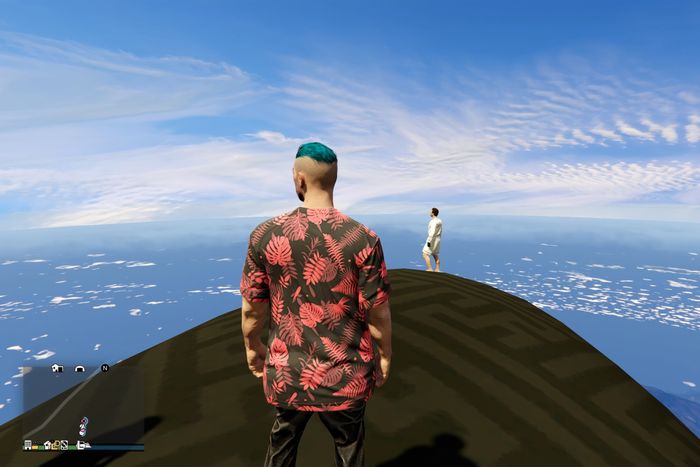
Sam Crane and Mark Oosterveen are working actors, and January 2021 was an especially rough time to be a working actor in the U.K. The film and television industries had slowed to a crawl, the country had just gone into its third lockdown, and the theaters were closed, which must have smarted for Crane, who’d just been cast as Harry Potter in the West End production of Harry Potter and the Cursed Child. Early on in Grand Theft Hamlet, there’s a scene in which Crane and his wife, documentarian Pinny Grylls, discuss his malaise. “It’s shit — everything’s shit. I have nothing now,” he says, before talking about how the coding class he’s been taking reminds him of the misbegotten line of government-backed ads touting a ballerina retraining for a second career in tech as though the concept of dance were already archaic. The conversation they have is awash with that particular flavor of COVID-related despair where it felt like so many delicate and precious things were being lost and wouldn’t survive into whatever new normal we eventually returned to. What sets it apart is that Crane and Grylls are represented onscreen by avatars in blue undercuts and skeleton pants, and they’re wandering around a luxe apartment overlooking the city of Los Santos in Grand Theft Auto Online.
Grand Theft Hamlet, which Crane and Grylls co-directed, may have been born out of the pandemic. But watching the documentary now, in these shambolic early days of 2025, it feels more like an elegy for the internet. The internet is still around, of course, as is the online multiplayer version of Rockstar Games’ flagship franchise in whose sprawling digital world Grand Theft Hamlet was filmed. But it’s also unmistakably ending, at least as we’ve come to know it in the last few decades, as the big platforms everyone was coaxed onto flounder through different stages of decline at the direction of egomaniacal owners and dead-eyed executives. In the social-media era, the internet has simultaneously served as an escape from the real world and a direct extension of it. And if that contradiction has been splintering our psyche as a species, it’s also the source of a lot of delight and unexpected connection, both of which are amply on display in this winning film. With nothing else going on, Crane and Oosterveen have been spending long stretches in the fictionalized Los Angeles of the game, shooting the shit while shooting at NPCs, other players, and the cops who come swarming. During one of these hangouts, they stumble upon Los Santos’s answer to the Hollywood Bowl, and while exploring the gorgeously rendered, empty amphitheater, they wonder if it’d be possible to put on a production inside the game. Maybe Shakespeare? People play GTA to indulge in violence, but that’s something the Bard had a taste for, too.
Grand Theft Hamlet is the chronicle of the improbable production of Hamlet the two men begin to plan in that moment, half internet stunt and half earnest attempt at art made more real by the fact that Grylls joins and starts documenting the action using the in-game camera effect. The main joke sounds like it stems from this combination of high and low, but the actual humor driving the film comes more from what it means to subvert the intentions of a gleefully crass corporate product for another use. The two men put a call out for auditions, eventually shooting a promo video on the beach that is hilariously interrupted by police who rappel down on ropes, Oosterveen trying to hold them off while Crane tries to finish his pitch. “You can’t stop art, motherfuckers!” he hollers, at which point both of them get gunned down — the game-over screen, declaring the player “Wasted” over a black-and-white shot of their corpse, becomes a repeat punchline in the pair’s efforts to get work done in a game that encourages casual carnage. They do, eventually, get an ensemble together that’s made up of online recruits and people the two know in real life. They gather some allies as well, like a Tunisian-Finnish man named ParTeb who dresses as an alien and likes flashing his avatar’s extraterrestrial ass, and is coaxed into reciting some lines from the Quran onstage in a moment that’s genuinely lovely.
Those flashes of vulnerability and aesthetic grandeur are as valuable as the many moments of absurdity that mark the film, even if those are also the times when you’re reminded that Grand Theft Hamlet is not just a lark, but a savvy project from stalled-out creatives hoping to make something of all this spare time. Oosterveen, who lives alone and has no living family, talks with Grylls about his loneliness while Crane, in the real world, has gone off to use the bathroom. Nora, one of the cast members found online, mentions having recently come out as trans to her family, and says that she relates to Hamlet in that he’s also trying to find his own truth. It’s not that these scenes don’t feel genuine, but they also read as an effort to add a little ballast to a feat that we don’t ultimately see that much of, because it’s the journey, not the destination, that’s interesting. Still, when the production stages the ghost scene on top of a blimp that soars high above the ridiculously intricate cityscape, it’s sublime — a repurposing of all the casual beauty usually consigned to the background of digital carnage for other purposes. Then the blimp crashes and the whole cast dies, only to come back and pick up where they left off. You can’t stop art, motherfuckers, and whether it’s in Grand Theft Auto Online or during a global pandemic, the show must go on.


